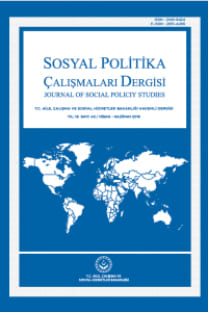Domestic violence in Turkey: An example of ağri province
Türkiye de aile içi şiddet : Ağrı ili örneği
___
- Aksoy, E., Cetin, G., Inanici, M. A., Polat, O., Sozen, S. & Yavuz, F. (1999), Domestic Violence, Retrieved on October 12, 2011 from www.ttb.org.tr.
- Akyuz, G., Kugu, N., Dogan , O, & Ozdemir, L. (2002). Bir Psikiyatri Poliklinigine Basvuran Evli Kadın Hastalarda Aile Ici Siddet, Evlilik Sorunları, Basvuru Yakinmasi ve Psikiyatrik Tani, Yeni Symposium, 40 (2), s. 41-48.
- Altinay, A.G. & Arat, Y. (2007), Report on Violence against Women in Turkey, Punto Publications, Istanbul.
- Audi, R. (1971), On the Meaning and Justification of Violence, In Schaffer, J. (Eds.) Violence, New York: McKay.
- Belkin, G.S. &Goodman, N. (1980), Marriage, Family, and Intimate Relationship, Rand Mcnally College Publishing Company, Chicago.
- Dogutas, A. (2011), an Age of Democracy and Girls Education in Turkey: Cross-Cultural and International Analysis, International Review of Turkish Studies, 1 (1), pp. 8-19.
- Elliot, D. S., Hamburg, B. & Williams, K.R. (1998), Violence in American Schools, Cambridge University Press.
- Erbek, E., Eradamlar, N., Beştepe, E., Akar, H. & Alpkan, L. (2004), Thinking Man, 17(4), pp. 196-204.
- Frazer, M. (1986), Domestic Violence: A Medico-legal Review, Journal of Forensic Sciences, 31, pp. 1409-1411.
- Gelles, R.J. (1985), Family Violence, Ann Rev Social, 11, pp. 347-67.
- Gulcur, L. (1999), A Study on Domestic Violence and Sexual Abuse in Ankara, Turkey, Retrieved on 22 March, 2012, from http: //www.kadinininsanhaklari.org/smages/ sexual_abuse.pdf Guler, N., Tel, H., & Ozkan Tuncay, F. (2005), Womens Perceptions on Violence Within Family, C. U. Journal of Medicine Faculty, 27(2), pp. 51 56.
- Heise, L. & Garcia-Moreno, C.( 2002), Violence by Intimate Partners, World Report on Violence and Health, In Etienne G. K. , Linda L. D., James A. M., Anthony B. Z., & Rafael L. Geneva: World Health Organization.
- Icli, T. (1995). Kriminoloji (Criminology). Bizim Buro Basimevi. Ankara.
- Ilkkaracan, P. & Gulcur, L. (1996). Aile Icinde Kadina Karsi Siddet (Violence against Women in the Family). In Sicak Yuva Masali: Aile Ici Siddet ve Cinsel Taciz, eds. Pınar Ilkkaracan, Leyla Ggulcur and Canan Arin, 21-39. Istanbul: Metis Yayinlari.
- Johnson, H. (1998), Rethinking Survey Research on Violence Against Women, In Dobash, H. & Emerson, R. (Ed); Dobash, Russell P. (Ed), Thousand Oaks, CA, US: Sage Publications.
- Kadinin Statusu Genel Mudurlugu (Directorate General on the Status of Women) (KSGM). (2008). Kadina Yonelik Aile Ici Siddetle Mucadele Ulusal Eylem Plani 2007-2010, Ankara.
- Kocacik, F. & Caglayandereli, M. (2009). Ailede Kadina Yonelik Siddet: Denizli Ili Ornegi (Violence against Women in the Family: An Example of Denizli). Uluslararasi Insan Bilimleri Dergisi. 6(2). Access: http://www.insanbilimleri.com
- Krug, E.G., Dahlberg, L.L.&, Mercy, J.A. (2002), World Report on Violence and Health, Geneva, World Health Organization.
- Mor Cati Kadin Siginagi Vakfi, (1996). Evdeki Teror: Kadına Yonelik Siddet (Terror at Home: Violence Against Women). Istanbul: Mor Cati Yayinlari.
- Nadelson, C.C. (1996), Vulnerability and Response to Trauma in Women: Developmental Issues, In Nersessian, E. &Kopff, R. (Eds.) Textbook of Psychoanalysis, APA Press, Wahington.
- National Action Plan on Fight against Domestic Violence toward Women 2007 2010, (2007), Prime Ministers General Directorate for the Statute of Women, Ankara.
- Prime Ministers Institution of Family Research (1995), Domestic and Community Violence, Family Research Institution Publications, Ankara.
- Prime Ministers Institution of Family Research (1998), Domestic and Community Violence, Family Research Institution Publications, Ankara.
- Tjaden, P. &Thoennes, N. (2000), Full Report of the Prevalence, Incidence, and Consequences of Violence against Women: Findings From the National Violence Against Women Survey, Washington, D.C. US Department of Justice, Office of Justice Programs, National Institute of Justice.
- Turkish Statistical Institute (2013). Retrieved from http://tuikapp.tuik.gov.tr/kadinasiddetdagitim/ kadin.zul on 10.11.2013.
- Turkish Statistical Institute (2012). Ağrı With Chosen Indicators (Secilmis Gostergelerle Ağrı).Turkiye Istatistik Kurumu Matbaasi, Ankara.
- UNICEF, (2000), Domestic Violence against Women and Girls, Innocenti Digest, 6. Florence: UNICEF Innocenti Research Center.
- Uniform Crime Reports. (1991). Federal Bureau of Investigation.
- Ucecam Karagel, D. (2009), Illiteracy Rates of Women Population in Suburban Parts of East Anatolia Region (2000), East Anatolia Region Researches, 8 (1), pp. 14-23.
- World Health Organization (2013). Violence. Retrieved from http://www.who.int/topics/ violence/en/ on 14.11.2013.
- VAKAD. (2013). 2011 Year Statistics of Violence Applications. Retrieved from www.vakad.org.tr on 05.11.2013.
- Violence Against Women (October, 2013). World Health Organization, Factsheet No:239.
- Vahip, I. & Doganavsargil, O. (2006), Domestic Violence and Women Patients, Turkish PsychiatryJournal, 17(2), pp. 107-114.
- Yildirim, A. (1998). Siradan Siddet (Ordinary Violence). Boyat Kitaplari, No: 9. İstanbul.
- Yuksel, S. (1993). Es Dayagi ve Dayaga Karsi Dayanisma Kampanyasi (Partner Beating and Cooperation Campaign against Beating). In 1980ler Turkiyesinde Kadin Bakis Acisindan Kadinlar, ed. Sirin Tekeli, 341-350. Istanbul: Iletisim Yayinlari.
- ISSN: 2148-9424
- Yayın Aralığı: 4
- Başlangıç: 2012
- Yayıncı: Aile,Çalışma ve Sosyal Hizmetler Bakanlığı
Aile yılmazlığı: Bir engele rağmen birlikte güçlenen aile
Sultan II. Abdülhamid döneminde sosyal politika uygulamaları
The views and behaviours of women on the distribution of responsibility in household activities
Domestic violence in Turkey: An example of ağri province
Mobbing ölçeği: Geçerlik ve güvenirlik çalışması
Ayşegül LALEOĞLU, Emine ÖZMETE
Ebeveyn eğitim programının annelerin ebeveynlik öz-yeterliklerine etkisi
